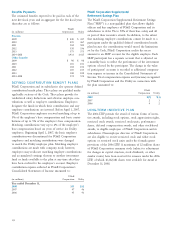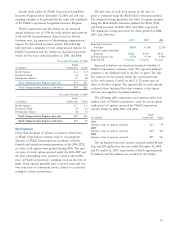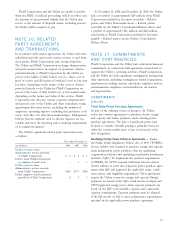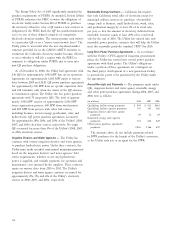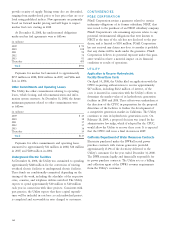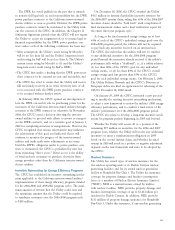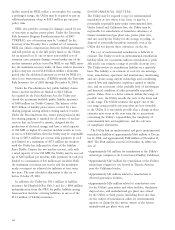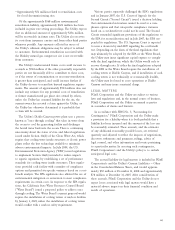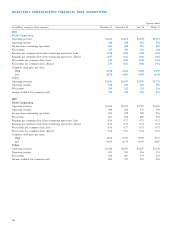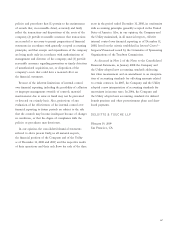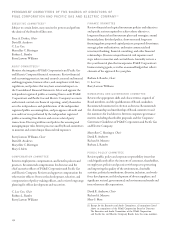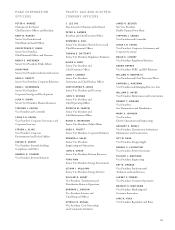PG&E 2008 Annual Report Download - page 144
Download and view the complete annual report
Please find page 144 of the 2008 PG&E annual report below. You can navigate through the pages in the report by either clicking on the pages listed below, or by using the keyword search tool below to find specific information within the annual report.142
ENVIRONMENTAL MATTERS
The Utility may be required to pay for environmental
remediation at sites where it has been, or may be, a
potentially responsible party under environmental laws.
Under federal and California laws, the Utility may be
responsible for remediation of hazardous substances at
former manufactured gas plant sites, power plant sites,
and sites used by the Utility for the storage, recycling, or
disposal of potentially hazardous materials, even if the
Utility did not deposit those substances on the site.
The cost of environmental remediation is diffi cult to
estimate. The Utility records an environmental remediation
liability when site assessments indicate remediation is prob-
able and it can estimate a range of possible clean-up costs.
The Utility reviews its remediation liability on a quarterly
basis. The liability is an estimate of costs for site investiga-
tions, remediation, operations and maintenance, monitoring,
and site closure using current technology, and considering
enacted laws and regulations, experience gained at similar
sites, and an assessment of the probable level of involvement
and fi nancial condition of other potentially responsible
parties. Unless there is a better estimate within this range of
possible costs, the Utility records the costs at the lower end
of this range. The Utility estimates the upper end of this
cost range using possible outcomes that are least favorable
to the Utility. It is reasonably possible that a change in these
estimates may occur in the near term due to uncertainty
concerning the Utility’s responsibility, the complexity of
environmental laws and regulations, and the selection
of compliance alternatives.
The Utility had an undiscounted and gross environmental
remediation liability of approximately $568 million at Decem-
ber 31, 2008, and approximately $528 million at December 31,
2007. The $568 million accrued at December 31, 2008 con-
sists of:
• Approximately $51 million for remediation at the Utility’s
natural gas compressor site located near Hinkley, California;
• Approximately $167 million for remediation at the Utility’s
natural gas compressor site located in Topock, Arizona
near the California border;
• Approximately $83 million related to remediation at
divested generation facilities;
• Approximately $216 million related to remediation costs
for the Utility’s generation and other facilities, third-party
disposal sites, and manufactured gas plant sites owned
by the Utility or third parties (including those sites that
are the subject of remediation orders by environmental
agencies or claims by the current owners of the former
manufactured gas plant sites); and
facility insured by NEIL suffers a catastrophic loss causing
a prolonged outage, the Utility may be required to pay an
additional premium of up to $39.3 million per one-year
policy term.
NEIL also provides coverage for damages caused by acts
of terrorism at nuclear power plants. Under the Terrorism
Risk Insurance Program Reauthorization Act of 2007
(“TRIPRA”), acts of terrorism may be “certifi ed” by the
Secretary of the Treasury. For a certifi ed act of terrorism,
NEIL can obtain compensation from the federal government
and will provide up to the full policy limits to the Utility
for an insured loss. If one or more non-certifi ed acts of
terrorism cause property damage covered under any of the
nuclear insurance policies issued by NEIL to any NEIL mem-
ber, the maximum recovery under all those nuclear insurance
policies may not exceed $3.24 billion within a 12-month
period plus the additional amounts recovered by NEIL for
these losses from reinsurance. (TRIPRA extends the Terrorism
Risk Insurance Act of 2002 through December 31, 2014.)
Under the Price-Anderson Act, public liability claims
from a nuclear incident are limited to $12.5 billion.
As required by the Price-Anderson Act, the Utility pur-
chased the maximum available public liability insurance
of $300 million for Diablo Canyon. The balance of the
$12.5 billion of liability protection is covered by a loss-
sharing program among utilities owning nuclear reactors.
Under the Price-Anderson Act, owner participation in this
loss-sharing program is required for all owners of nuclear
reactors that are licensed to operate, designed for the
production of electrical energy, and have a rated capacity
of 100 MW or higher. If a nuclear incident results in costs
in excess of $300 million, then the Utility may be responsible
for up to $117.5 million per reactor, with payments in each
year limited to a maximum of $17.5 million per incident
until the Utility has fully paid its share of the liability.
Since Diablo Canyon has two nuclear reactors, each with
a rated capacity of over 100 MW, the Utility may be assessed
up to $235 million per incident, with payments in each year
limited to a maximum of $35 million per incident. Both
the maximum assessment per reactor and the maximum
yearly assessment are adjusted for infl ation at least every
fi ve years. The next scheduled adjustment is due on or
before October 29, 2013.
In addition, the Utility has $53.3 million of liability
insurance for Humboldt Bay Unit 3 and has a $500 million
indemnifi cation from the NRC for public liability arising
from nuclear incidents covering liabilities in excess of the
$53.3 million of liability insurance.


